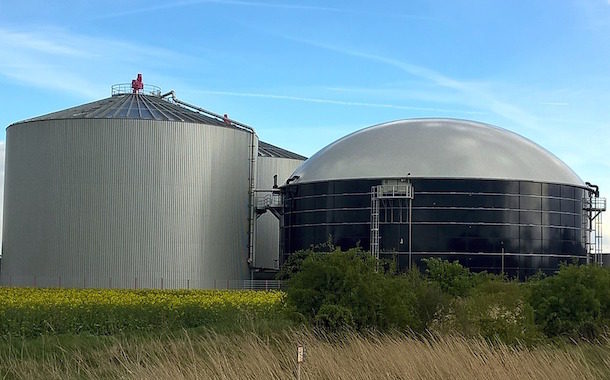Energy from waste – the rise of biogas

Could biogas be the answer to excessive food wastage in Australia, not to mention an opportunity to decrease the use of fossil fuels? Alan Stevenson ponders the benefits of biogas from anaerobic digesters.
There has been ongoing discussion about the enormous food wastage in both Australian homes and along the production line. Some produce is discarded before it even leaves the farm gates, deemed too unsightly for the supermarket shelves; bruised, damaged or old food is discarded from supermarkets and unused or uneaten food from restaurants ends up in the waste disposal. As householders, we tend to throw away spoiled fruit and vegetables; forgotten items from the fridge and left-overs. Many local governments now have special recycling bins, allowing their residents to buy foodstuffs back once it has been turned into compost, however these are few and far between.
The idea of personal household composting does not appear to have caught on and is intermittently distributed. However, some people are now using anaerobic digesters. When organic matter, like kitchen waste, breaks down without oxygen present it produces methane, which can be burned as a natural gas. When this gas is filtered to remove the hydrogen sulfide (bad egg gas), along with several other poisonous gases, it can be used in a normal gas stove. These digesters can be bought and installed for around $1000. The waste can then be used in the garden as a fertiliser.
The Victorian State Government has produced a document, ‘Turning Waste into Energy‘ calling for more discussion on the subject. We are aware that the sewerage treatment plant at Werribee is largely powered with biogas, as are many other similar plants; around 2% of our electricity comes from biogas at present. The uptake of this technology has produced significant energy savings and environmental improvements for red-meat processing plants such as the JBS Dinmore facility and the AJ Bush Beaudesert rendering plant, both located in South-East Queensland.
The recent installation of covered anaerobic lagoons by Oakey Beef Exports and Darling Downs Fresh Eggs demonstrates the huge potential to adopt biogas technology in one of Australia’s key livestock-producing and food-processing regions.
Interest in using biological feedstock, including manure, has encouraged the Federal Government’s Australian Renewable Energy Agency (ARENA) to fund Australia’s involvement in the International Energy Association’s (IEA) Bioenergy Task 37: Energy from Biogas.
This funding, secured through the industry-funded body Bioenergy Australia, means Australia can sit at a table of global representatives to look at what is going right and what is going wrong in biogas production systems around the world.
As already noted, when organic matter biodegrades under anaerobic conditions, methane is produced. It has been estimated that each year between 590 million and 800 million tones of methane is released into the atmosphere. This is bad news for the climate – pound for pound, methane is a far more potent greenhouse gas than CO₂.
But in a biogas system this methane is captured and ultimately converted to CO₂ when the fuel is burned. Because that CO₂ was going to end up in the atmosphere anyway through natural degradation, biogas has zero net emissions.
There are other benefits too. The organic matter used in biogas digesters is typically a waste product. By using biogas we can reduce the amount of food waste and other organic materials being sent to landfill.
Furthermore, biogas systems produce a nutrient-rich sludge that can be watered down into a fertiliser for gardens or farms. All of this can help to develop increased energy independence, build resilience and save money. A purchaser of a digester discusses the experience in a recent article in ‘The Conversation’ which is an insightful look at the experiment he undertakes in his family home.

Alan Stevenson spent four years in the Royal Australian Navy; four years at a seminary in Brisbane and the rest of his life in computers as an operator, programmer and systems analyst. His interests include popular science, travel, philosophy and writing for Open Forum.
















Christian Wallace
February 9, 2018 at 5:26 pm
Thanks Alan, interesting report. I forgot about how wasteful we are with food. I, too, appreciate any efforts made to build on our renewable energy or reclaimed energy efforts. I’m sure it wouldn’t be difficult to convert the farms providing the surplus food to run their tractors and other combustion engine machinery/generators etc. So, there is ever expanding hope for our energy needs in tbe future! Thanks for the paper, cheers Christian
Max Thomas
February 28, 2018 at 8:47 am
A good thing in principle, Alan, but it’s likely that the necessary regulatory regime would tend to discourage widespread adoption of household biogas. The backyard swimming pool was once a valuable asset, but thousands of neglected pools have been filled in to increase the market appeal of real estate that pools were once thought to enhance. Maintenance and safety are serious ongoing issues for pool owners. But the effort, skill and diligence required to efficiently produce, store and use biogas safely are at the ‘deep end’ of the alternative energy spectrum. The efficiency of PV solar panels is poorer than it could be because people forget to clean them.
It’s beyond the scope of your article, but another key point to consider is climate. Digesters in southern Australia need supplementary heating during the colder months and much of the gas produced is consumed for this purpose. Environment protection agencies and local authorities have always struggled with the health and environmental problems caused by poorly installed and neglected septic tanks. It seems unlikely that they will embrace something that would inevitably create a significant rise in nuisance and pollution complaints.